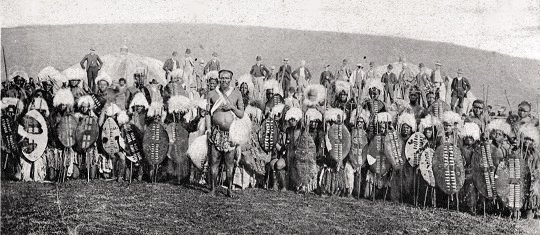
The Zulu clan, originally called Abaguni, dates back to the early 18th century CE.
It rose to power in the early 19th under Shaka.
He united the loose confederation of tribes that had existed before and forged a kingdom with himself at the head.
He achieved this by instituting several sweeping changes, though not all can be contributed to Shaka himself; several were started by his predecessors.
Early south African warfare was internal and frequent, yet small scale and ritualistic, often over disputes about cattle.
This changed with the rise of Dingiswayo (not a Zulu, but a mTetwa chief) and Shaka.
Population growth, slavery, conflicts with neighboring tribes and the example of Europeans made the Zulu militarize.
Especially under Shaka the impi adopted aggressive tactics.
Shaka broke up the traditional clan groups, to prevent rebellions.
He strengthened the organizing of warriors in age-groups, each forming an "iButho", a regiment.
Shaka and his successors conscripted men young and did not allow them to marry until they were in their mid-30's, thus maximizing their period of service.
Each regiment had its own kraal, name, symbols and shield colors.
Regimental pride was high and there was strong rivalry among them.
The regiments were not a standing army, but at mobilization all fit adult men except witch-doctors could be called up.
This usually happened in the winter, when the harvest was in and the hands were free for waging war.
Armies, regiments and smaller units were commanded by older, experienced warriors who both constrained impetuous youths and bolstered the cowards.
The Zulu army lacked horses, but was trained to make long though swift marches on foot, giving it strategic mobility.
It is rumored that Shaka discarded sandals, forcing his men to walk and run barefoot, which allowed for faster running.
More likely they marched on sandals and maybe put them aside in battle.
Supplies, spare weapons, camp gear and other material were handled by "izinDibi", young boys, one per three warriors.
They carried enough food for about two days.
On longer campaigns they also drove a herd of cattle, a walking larder of meat.
For the rest the army had to live off the land.
Traditionally the Zulu fought with "ipapa", a relatively long and heavy javelin.
Around the time of Shaka this was supplemented by the "iKlwa", a short, heavy stabbing spear,
the "iWisa", a club
and the "isiHlangu", a sturdy cowhide shield.
This allowed for aggressive close-up attacks.
In battle, the Zulu liked to use encirclement tactics.
They often employed a 'buffalo horn' formation, where the main body and reserve formed the head of the buffalo and the wings the horns.
The Zulu military transformations and also the inroads made by Europeans, affected all neighboring tribes, upsetting the balance of power in the entire south of Africa.
This is called the Mfecane, which ranged from about 1815 CE to 1840 CE.
In the 1830's CE Boers were pushed north by the British and came into conflict with the Zulu.
When the Boers and British started a war in 1842 CE, the Zulu sided with the latter.
However in 1878 CE the British were powerful enough to take on the Zulu themselves and started the Anglo-Zulu war.
After an initial victory at Battle of Isandlwana the Zulu army was defeated, disbanded and the kingdom broken up.
War Matrix - Zulu Army
First Industrial Revolution 1750 CE - 1830 CE, Armies and troops


